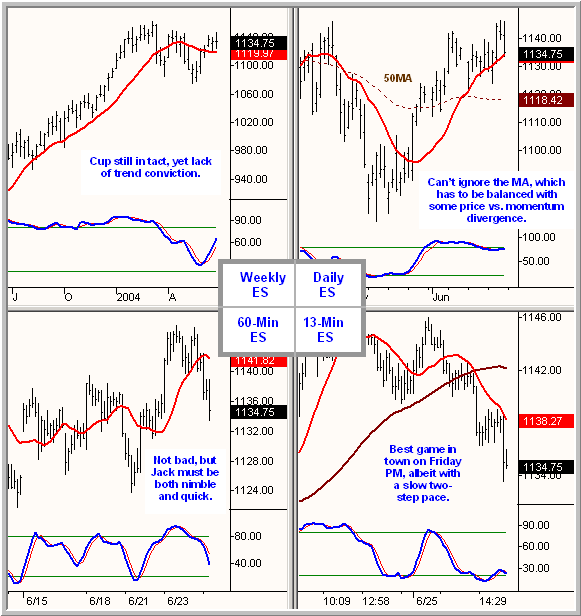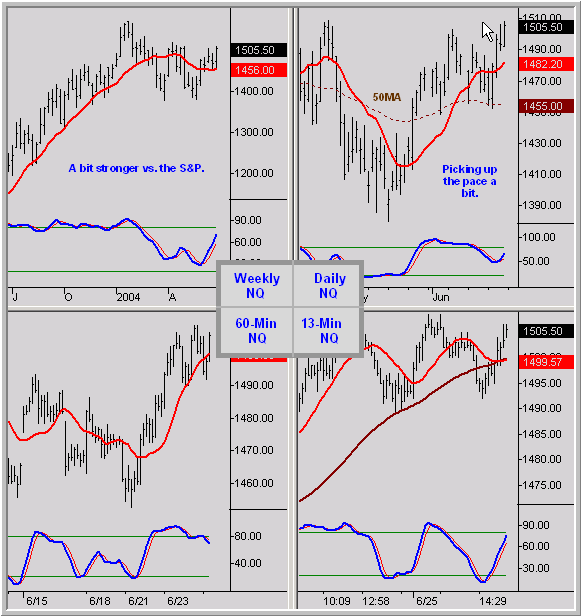What You Need To Generate Future Income…
Major U.S. markets split at
the virtual fork in the road late on this summer Friday,
as the S&P limped into the close with a four point
post-4:00 PM meltdown — while the Nasdaq added to its modest weekly gain. For
the week, the S&P stood still on a net basis, gaining a whopping 0.75 (that’s 75
basis points gang), while the Nasdaq added just under 40. The DAX tacked
on 13 in what has become an unusually tight range in the German index. Monkey
see, monkey do.
Volatility was slightly improved this week to aid those choosing to trade the
summer market on a trend basis, and rebalancing may have added to late Friday’s
U.S. volatility on an otherwise snoozefest of a day. Trend continuation
triggers worked well out of bear and bull flags on the 13 and above, and the
market provided one decent pullback sequence during the week on the 13, 60, and
120 timeframes. Yet the three- and/or five-minute charts were often key on runs
as low volume and lack of strong trend supports in terms of sharply angled
moving averages and/or higher ADXs on the larger timeframes continues to provide
summertime challenges. All in all, not bad, but not great, and traders are
still looking for improved “pace” and less chop.
Let’s hit the charts and then chat about dealing with the trading equivalent of
a double-bogey using Thursday’s trade as an example.
                                             Â
S&P 500

Â
                                          Â
Nasdaq 100

                                   Â
Moving Avg Legend:Â
15MAÂ Â Larger
Timeframe 15MA
                                  Â
See https://www.donmillertrading.com for Setups and Methodologies
                                                                 Â
Charts © 2004 Tradestation
^next^
Thursday’s Trading
My trading on Thursday afternoon sucked. The patterns were there, both in
real-time and in hindsight, but it was as if the connection between brain and
fingers was significantly severed. (System traders delight … we each have
our day.)Â And while sometimes the net daily proceeds (+ or -) don’t have
any relevance to how well or poorly one traded, the tally at the end of Thursday
did. In fact, I think the warning signs began on Wednesday afternoon, perhaps
not coincidently after I completed a midday radio interview, when I then
proceeded to do something I try hard to avoid — trade in the late afternoon.Â
As a rule, experience has taught me that the markets are much more predictable
in the earlier sessions, perhaps in part to my own state of alertness in the
morning, and so I try to trade accordingly which includes using the afternoon
action primarily to set up the morning trade.
Now for those new to this piece, you may find it strange to be hearing a
successful and published trader talk openly about his screw-ups. Yet I’ve said
from day one that this piece is about realism, versus the pristine “Here’s
the hindsight chart” or “No one ever has a losing trade or bad day”
in this business that seems to often dominate the industry press. And for those
new to this business, if you think there comes a day when experienced traders
rid themselves of an occasional poorly executed sequence or bad day, I have some
2003 World Champion Red
Sox shirts for you (and some from
1975 & 1986). For me, writing about them also happens to be a bit
therapeutic as it gives me a chance to study what went wrong as we dissect the
effort together.
As I said, I think the errors began back on Wednesday and carried into
Thursday’s trading. In both days, the overnight Globex and early morning (U.S.
time) trade went very well, at nearly 100% success, yet for some reason I felt
compelled to trade the afternoon when index trade often tends to be rather
sloppy. And while I came up with a few possible reasons or triggers, including
complacency after the interview, trading for the 100th consecutive day (to the
day) since joining the CME, letting my guard down in the midst of a rather
strong six-month success run (86% win/loss), and approaching a rather key
earnings benchmark on my equity thermometer, the reason is irrelevant and akin
to looking for an excuse. It happened, and it was time to address it
immediately.
As I’ve said many times publicly in the past, I consider my confidence my most
important asset — more than any capital balance — for without it, future
income is impossible. And the only trade I care about is the next one.
So how does one restore confidence after a double-bogey? While I wish I had the
magic answer, all I can do is share what I try to do and what I did. Part of
the answer was clear: Don’t trade Friday afternoon. Duh. The second part was
also clear. Don’t break part one. After all, handcuffs are difficult to put on
by oneself.
The other part of the answer was also clear — yet required more than just
sitting on one’s hands — which was to restore confidence going into the weekend
by a strong early Friday sequence.Â
Please note I said “a strong
sequence” with no financial target attached. The worse thing one can do
is try to eagle a hole following a double-bogey which generally leads to
consecutive double-bogeys, triple bogey, etc. There’s nothing like a solid par
after a hell hole. Again, experience over theory.  At
this end, I chose to change markets for a better sense of “freshness” and traded
both the Euro FX and DAX in the wee early morning of the U.S. Fortunately, I
was presented with three first pullback scalp trades which I took, executed
effectively, booked the profits, and had zero interest in trading after
8:00 A.M. ET, effectively taking today off as part of a needed three-day
weekend.
Now some may question whether the course of action was the right thing to do,
which included monitoring, but passing on a few Friday trade setups that
presented themselves that would have worked out well. Call it added opportunity
cost in terms of lost profits on top of a tangible loss on Thursday. And
perhaps they would be right. Yet all I know is what works and doesn’t work for
me, and choosing to pay the market on Friday — in the context of lost
profits on passed trades — in order to maintain the restored confidence over
the weekend is without question the right course of action for this trader.
I can’t stress enough that one can’t put a price tag on trading confidence, for
it’s what will generate any and all future income, which is the only income that
matters as of this point in time. And nothing will erode the confidence
faster and further than an extended period of poor trades.
Was it the right thing to do? Some will say the opportunity cost on Friday was
too high and that repeated two-day patterns like this will simply lead to
cumulative losses over time. All I can say that since joining the CME in early
2004, trading every day and going to lengths to avoid an extended losing period
by incurring opportunity cost on occasion, I’ve had consecutive draw days only
three times — twice at two and once at three. (Trading Pit seminar
attendees will remember one, in the midst of our very successful week.)Â And
while most know that I try to go great lengths to avoid personally discussing
successes, I will share for the purpose of illustration that the greatest
profitable sequence has been 34 trading days, and the most important and
arguably only relevant statistic — net capital growth — has been consistent
and on budget every month, and remains so today. Again, is it right? It’s
right for me.
Yup, my trading was abysmal Thursday afternoon and net negative for Thursday and
Friday. Thursday’s afternoon sequence stink, stank, and stunk. And for those
who love to step on public figures when they screw up, I’ll even provide you
with the shoe. And it will happen again. Thankfully, this business has always
been, and will continue to be about the long haul, as in let’s see whose
standing after 15 rounds. As an independent trader, I care about my annual
bottom line … period. Major career-ending blowouts aside (food for another
day), one day or week, good bad or indifferent, doesn’t hold water.
I’m actually extremely thankful that the bogey happened on the 17th hole
(Thursday) and not the 18th (Friday), as nothing burns me more than stewing over
the weekend. Been there, done that. The market will be here on Monday.
Good Trading and Have a
Great Weekend.
Â
